Parasitic worms and other unhealthy organisms can infect humans. They transfer through contaminated food and water. These worms love the environment in your intestinal tract and can survive for months and even years without being noticed. They can cause several complications, from a poor night's sleep to malnutrition and intestinal blockages. Hundreds of different types of worms can infect humans, and they come in all sizes and shapes. Keep reading to learn more about parasitic worms with their pictures.
Common Types and Pictures of Worms in Humans
1. Round Worms
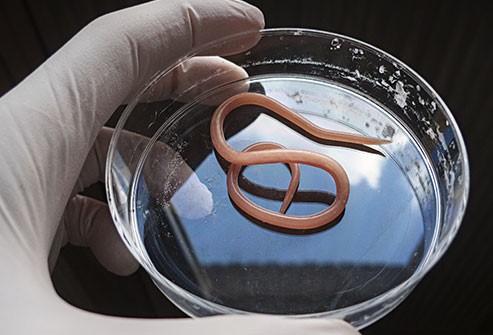 These large, round worms are present around the world. These pencil-thick worms can be several inches long and are further divided into different categories. The most common example is trichinella spiralis. You acquire these round worms through undercooked contaminated pork meat.
These large, round worms are present around the world. These pencil-thick worms can be several inches long and are further divided into different categories. The most common example is trichinella spiralis. You acquire these round worms through undercooked contaminated pork meat.
Symptoms of infection: These parasites can move from intestines to your muscles and other organs. They can form cysts in your organs and cause symptoms such as muscular and joint pain, abdominal pain, and swelling of the eyes with skin rash.
2. Flukes
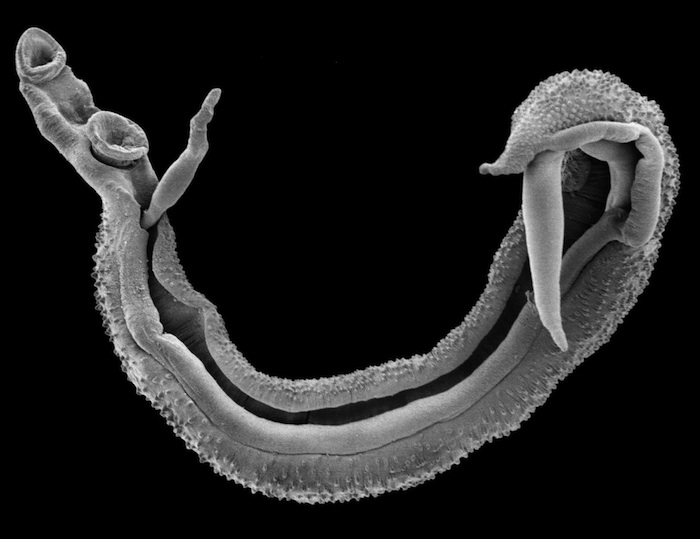 These types of parasitic worms are about half an inch long with about a millimeter of thickness. They are most commonly found in Africa, South America, and the Caribbean, and cause intestinal schistosomiasis. They live in your intestinal veins and lay eggs there that travel to the intestinal hollow and cause several complications. Presence of these eggs in the urine and stool helps make a diagnosis.
These types of parasitic worms are about half an inch long with about a millimeter of thickness. They are most commonly found in Africa, South America, and the Caribbean, and cause intestinal schistosomiasis. They live in your intestinal veins and lay eggs there that travel to the intestinal hollow and cause several complications. Presence of these eggs in the urine and stool helps make a diagnosis.
3. Tapeworms
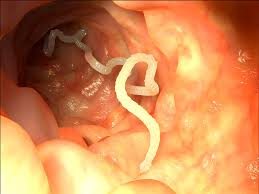 These are basically flat segmented parasitic worms and live in the intestines. They can be of different types, such as the following:
These are basically flat segmented parasitic worms and live in the intestines. They can be of different types, such as the following:
- Fish Tapeworm: It may be longer than 10m and usually spread through infected freshwater fish. It is more common in Russia, Europe, and America.
- Beef Tapeworm: These tapeworms are found in rural areas around the world and spread through undercook beef. They can be over 20m long.
- Dog Tapeworm: It is more common in cats and dogs, but humans can also become infected by ingesting contaminated dog fleas. You may find rice sized particles in your stool after you become infected with dog tapeworms.
4. Ascaris Worm
 Pictures of worms in humans will show that Ascaris is the most common human worm infection. These worms can be large and round with a length of up to 31cm. Male Ascaris worms have a curved tail, whereas females have a straightened tail and can be up to 35cm long. These worms do not usually move and absorb nutrients from the organs. Almost all humans get this type of worms from time to time.
Pictures of worms in humans will show that Ascaris is the most common human worm infection. These worms can be large and round with a length of up to 31cm. Male Ascaris worms have a curved tail, whereas females have a straightened tail and can be up to 35cm long. These worms do not usually move and absorb nutrients from the organs. Almost all humans get this type of worms from time to time.
5. Hookworm
 These worms can be up to half inch long and feed on human blood. If you become infected with these worms, you will experience symptoms such as loss of appetite, abdominal pain, iron and protein deficiency, craving to eat soil, skin irritation, mental dullness, and delayed puberty. In rare cases, these worms can lead to cardiac failure and death.
These worms can be up to half inch long and feed on human blood. If you become infected with these worms, you will experience symptoms such as loss of appetite, abdominal pain, iron and protein deficiency, craving to eat soil, skin irritation, mental dullness, and delayed puberty. In rare cases, these worms can lead to cardiac failure and death.
6. Threadworm or Pinworm
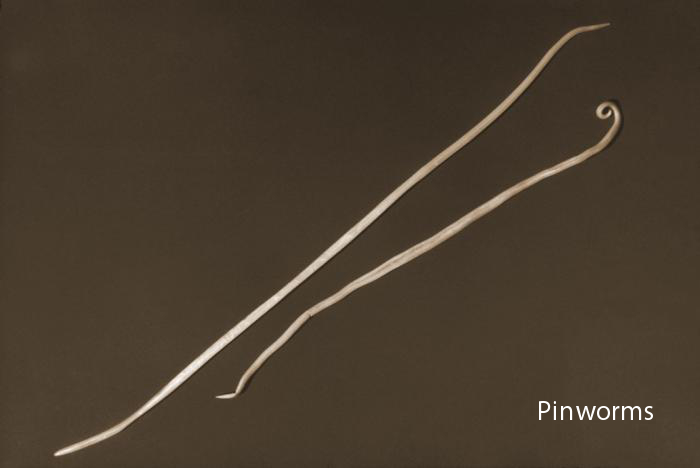 They are the most common types of worms, especially in children. They can be about half an inch in length but lay about 15,000 eggs every day at the opening of your anus. The most common symptoms include irritation and itching of the vagina or anus. You may also experience insomnia, digestive disorders, nervousness, and irritation. These worms come out through the anal opening at night to lay eggs. These eggs can spread through air and infect others as well. They can also pass through sharing of toys, foods, etc., and are not affected by disinfectants.
They are the most common types of worms, especially in children. They can be about half an inch in length but lay about 15,000 eggs every day at the opening of your anus. The most common symptoms include irritation and itching of the vagina or anus. You may also experience insomnia, digestive disorders, nervousness, and irritation. These worms come out through the anal opening at night to lay eggs. These eggs can spread through air and infect others as well. They can also pass through sharing of toys, foods, etc., and are not affected by disinfectants.
7. Whipworm
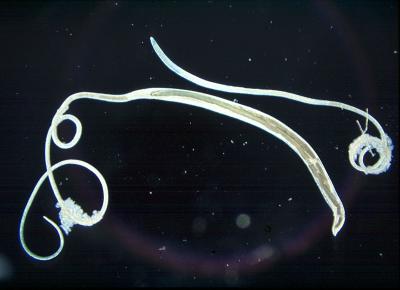 A look at pictures of worms in humans shows that whipworms have whip-like shape and are up to a couple of inches long. They infect millions of people worldwide and spread when humans put contaminated fingers in the mouth. They may also spread through contaminated food. When the infection is not severe, you usually do not experience any symptoms. In severe cases, you notice pain in the lower abdomen, bloody stools, nausea, weight loss, and anemia. Heavy infections may cause retarded growth in children. Medications are available to help treat these parasitic infections.
A look at pictures of worms in humans shows that whipworms have whip-like shape and are up to a couple of inches long. They infect millions of people worldwide and spread when humans put contaminated fingers in the mouth. They may also spread through contaminated food. When the infection is not severe, you usually do not experience any symptoms. In severe cases, you notice pain in the lower abdomen, bloody stools, nausea, weight loss, and anemia. Heavy infections may cause retarded growth in children. Medications are available to help treat these parasitic infections.
Sources of Worms in Humans
After knowing the common types of parasitic worms and seeing pictures of worms in humans, it is important to shed some light on the most common sources of worms in humans. You become infected when you follow poor hygienic practices. They spread through poorly sanitized water and food as well as poor personal hygiene. They can travel through water, food, and environment, or even through pets and insects. You can even become infected through sexual intercourse.
You are more likely to develop a parasitic infection when your immune system is weak due to over refined carbohydrates, sugar, heavy metals, alcohol, stress, or other health conditions. Consuming too much of dairy, wheat, coffee, and tap water also increase your risk of becoming infected with these parasitic worms.
Ways to Avoid Being a Host to Parasitic Worms
You can take certain steps to protect yourself from these parasitic worms. For instance:
- Never eat food that you think may have been in contact with human waste.
- Always wear gloves when working on soil that may have been contaminated with human waste.
- Avoid drinking or eating food where people do not practice sanitary disposal of human waste.
- Never eat raw fish or meat of any kind.
- Peel, wash, and cook all vegetables and fruits thoroughly before eating.
- Tell kids to never put fingers in their mouths.
- Wash your hands thoroughly before and after using the bathroom or changing a diaper.
- Never share your towels and washcloths with others.
- Avoid tap water and drink bottled water when in areas with poor sanitation.
- Dispose of used diapers properly.
